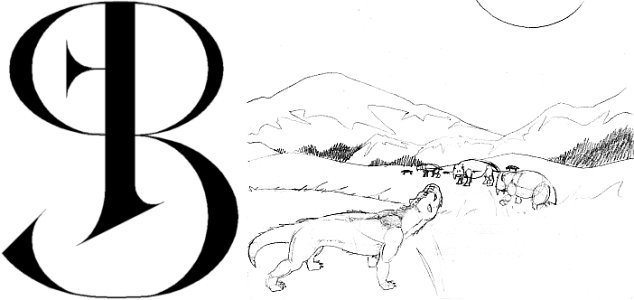
Xanadu is an island empire on the
Squawk world Peleg. The culture of Xanadu is modeled after asian countries such as China and Japan. This drawing was a sketch for a 3D Squawk game we started to develop set in Xanadu. The linear perspective and very limited use of atmospheric depth is more in the tradition of european art than asian art and the clash is akward.

This is a quick sketch for a
2D Squawk game we are beginning to develop. Vertical exaggeration, atmospheric perspective, and orthographic perspective (parallel lines look parallel in the image) give the scene the look of a Chinese ink painting, and lend themselves naturally to a 2D game engine.
The small garden shows how the game might be different from a painting. In a painting the left and right sides of the fence would be at an angle, making it difficult to sort out whether the fence should be drawn in front of or behind each character. In this design the sides of the fence are vertical to make sorting simpler.
This sketch was drawn over and around printed text, which I removed using the
GIMP's select-by-color tool, deselecting the parts I didn't want removed, growing the selection by one pixel, and clearing the selected area. If you look closely you can still see the holes where the text was.

This is another sketch for the Squawk 2D game. Four of the five intelligent species of Xanadu (Minotaur, Titan, Kobold, and Gargoyle), a theropod dinosaur ("lyndwyrm") and a sauropod ("behemoth") are shown in size comparison. The interior is shown with orthographic perspective typical of Japanese woodblock prints, and the exterior is shown in a simplified orthographic perspective like the garden above.

Here's a small wooden building with a different type of orthographic perspective, similar to the game Diablo. In a game, this image would be difficult to sort, so it would probably be broken down into parts which would be sorted seperately.

This tower was looking pretty good until I ran out of space at the top :-) The eight sides of the tower are inspired by Chinese pagodas, but also might represent the
eight elements of Xanadu's alchemy tradition: water, wood, earth, metal, fire, lightning, air and shadow, or the eight legs of the giant spiders which produce bulletproof spider-silk, the empire's most important product.

I tried to create a more alien style of architecture in this drawing. It's one of my favorites.
 In the Squawk role-playing game, kobolds are intelligent theropod dinosaurs. They are roughly humanoid in shape, except for having four fingers or toes on each limb, a prehensile tail and a typical theropod snout including a mouth full of sharp teeth. Kobolds are tree-climbing predators, with similarities to cats and primates. They are acrobatic and powerfully muscled for their size (about 1.6 m tall.)
In the Squawk role-playing game, kobolds are intelligent theropod dinosaurs. They are roughly humanoid in shape, except for having four fingers or toes on each limb, a prehensile tail and a typical theropod snout including a mouth full of sharp teeth. Kobolds are tree-climbing predators, with similarities to cats and primates. They are acrobatic and powerfully muscled for their size (about 1.6 m tall.)
















































